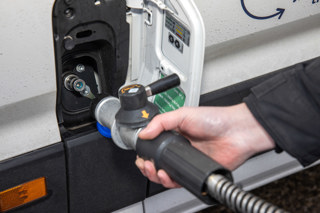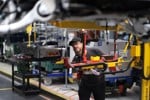Review
One of the biggest challenges when moving from diesel vans to electric ones is finding suitable charging solutions.
While there are plenty of electric vans on the market, now, and a growing number of public chargers, for those that use their vans for work, finding time to charge during the working day is essentially downtime. There’s also the cost of electricity, which makes relying on public infrastructure a more costly exercise than running diesel vehicles in many cases.
Perhaps that’s where hydrogen can provide a solution. There’s two types of hydrogen powertrain: a fuel cell, which generates electricity to power a motor, and combustion, which burns hydrogen like petrol or diesel fuel.
A fuel cell vehicle has zero tailpipe emissions, like an electric van, but it only takes a few minutes to fill the tank. A hydrogen fuel cell van can also go a lot further between fill ups, making day-to- day operation more akin to a diesel.
Why isn’t everyone running a hydrogen van then? Well, the answer is fairly simple. Hydrogen fuelling infrastructure is very much in its infancy in the UK, with only a handful of stations. There’s also no hydrogen fuel cell vans currently on sale.
First Hydrogen believes it may have a solution, however. The startup has developed a hybrid hydrogen fuel cell powertrain, which could be ready for series production in just a few years.

The prototype vehicle, we’re testing here, is based on a MAN eTGE. The van’s battery has been removed and First Hydrogen’s powertrain shoehorned in.
A trio of hydrogen tanks occupy the space under the van’s floor, while a compact fuel cell unit is placed under the bonnet. Electricity is sent to the MAN’s original drive motor.
The system is technically a ‘hybrid’ as it also contains a small battery, derived from a plug-in hybrid car. This helps smooth out the power delivery from the fuel cell and provides enough juice so the van can operate at full power when needed. At lower speeds and when driving in towns, the fuel cell can power down to minimise fuel consumption.
Technically the vehicle could be used like a plug-in hybrid, utilising a charging point, we were told by its creator. An intelligent management system looks after the powertrain, firing up the fuel cell when needed and keeping the battery topped up.
In trials, the prototype vehicle has managed to cover 400 miles before it needed refuelling, and has an anticipated real-world range of 373 miles.
What is it like to drive a hydrogen van?
Usually, if we describe a vehicle as ‘underwhelming’ in a review it may be perceived as a negative. But in the case of the First Hydrogen prototype, it’s a compliment. You see, the van drives exactly like a regular MAN eTGE. Because the original motor is used, it has the same performance and smoothness as the donor vehicle.
There’s a faint buzz and the odd hiss from under the bonnet, while a small tailpipe emits water droplets as the only emission.

Our drive time was limited and the purpose of our evaluation was purely to assess the powertrain, rather than the overall vehicle’s ride and handling characteristics.
From behind the wheel, there’s nothing to distinguish the hydrogen powered vehicle from an electric one. The throttle is responsive, and the van accelerates quickly and silently. It reaches the national speed limit with little effort and cruises happily. When lifting off the accelerator, regenerative braking kicks in, just like in an electric van.
We’re told that further planned developments will improve the refinement of the system even more, to the point where it’s pretty much indifferent to having a battery on board.
In terms of weight, the prototype carries a 300Kg penalty, but with an evolved version of the powertrain already on the cards, First Hydrogen’s ultimate goal is to engineer out the difference.
Can I buy one?
First hydrogen is still deciding what its long-term strategy is, before it brings anything to market. The MAN prototype could feasibly become a production vehicle, while the powertrain could equally be adapted to fit other electric vans. This could see it offered as a conversion or even factory fitted, if a manufacturer partnership was secured.
An alternative solution is for First Hydrogen to build its own van. While that requires significant investment, it’s an avenue the business is already exploring. Earlier this year it revealed the Generation II concept, which uses a streamlined, lightweight body on a skateboard-style platform.

The costs associated with hydrogen vans mean they still come at a premium, but the technology is in its infancy and further development should drive costs down.
Infrastructure is the real hurdle. Depot based fleets have the option of installing their own filling stations and even those businesses that send their vehicles home with drivers could overcome the issue of charging an electric van, if they can find adequate hydrogen refuelling capability.
While there are still some infrastructure and cost challenges to overcome, one thing is clear: a hydrogen fuel cell is a viable powertrain option for van operators that need a long-range zero-emission solution.
Matt has been an automotive journalist for nine years and has driven just about every new car and van that's on sale. As content editor - vehicles he is responsible for the automotive content on Fleet News and also contributes to Automotive Management. Prior to this, Matt worked in the automotive industry for 10 years.














 Diesel
Diesel

















Login to comment
Comments
No comments have been made yet.